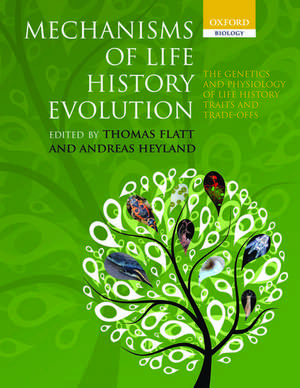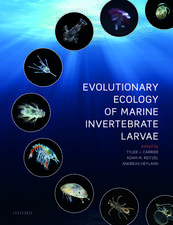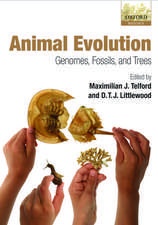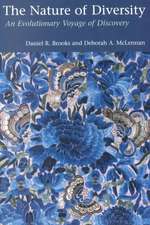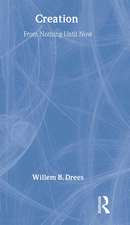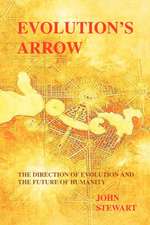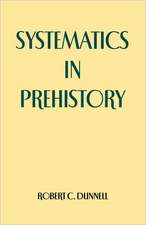Mechanisms of Life History Evolution: The Genetics and Physiology of Life History Traits and Trade-Offs
Editat de Thomas Flatt, Andreas Heylanden Limba Engleză Paperback – 11 mai 2011
| Toate formatele și edițiile | Preț | Express |
|---|---|---|
| Paperback (1) | 490.93 lei 31-37 zile | |
| OUP OXFORD – 11 mai 2011 | 490.93 lei 31-37 zile | |
| Hardback (1) | 889.61 lei 31-37 zile | |
| OUP OXFORD – 11 mai 2011 | 889.61 lei 31-37 zile |
Preț: 490.93 lei
Preț vechi: 566.98 lei
-13% Nou
Puncte Express: 736
Preț estimativ în valută:
93.96€ • 96.83$ • 79.33£
93.96€ • 96.83$ • 79.33£
Carte tipărită la comandă
Livrare economică 20-26 februarie
Preluare comenzi: 021 569.72.76
Specificații
ISBN-13: 9780199568772
ISBN-10: 0199568774
Pagini: 504
Ilustrații: 75 illustrations
Dimensiuni: 189 x 246 x 27 mm
Greutate: 1.1 kg
Editura: OUP OXFORD
Colecția OUP Oxford
Locul publicării:Oxford, United Kingdom
ISBN-10: 0199568774
Pagini: 504
Ilustrații: 75 illustrations
Dimensiuni: 189 x 246 x 27 mm
Greutate: 1.1 kg
Editura: OUP OXFORD
Colecția OUP Oxford
Locul publicării:Oxford, United Kingdom
Recenzii
[This book] single-handedly kept me off a computer for a long time and renewed my excitement about books. ... The content is motivating. Excellent chapters, sections and overview by the editors will turn this book into a much-read, dog-eared reference staple. Highly recommended.
Flatt and Heyland have clearly spent much time editing this book and have produced an effective template for an impressive set of authors, organised contributions into coherant sets with logical flow, and offer their own preview of each section. This provides readers with multiple points of access to the material. The content is motivating, the 25 chapters in this book shed light on many advances made ... For some, the most compelling aspects of this book will be the pair of chapters where Stearns and the editors argue over the merits of this "molecular natural history" ... these chapters make for one of the most exciting exchanges in print for a long time.
For years there has been a divide between biologists that asked why and those that asked how. This book integrates the two perspectives beautifully, while addressing the most fundamental of all aspects of an organism - its life history. Here we learn how adopting genetic, genomic, and physiological perspectives informs evolutionary patterns of birth, growth, reproduction, ageing, and death. This book comprehensively reviews and informs us about the latest developments in mechanistic and evolutionary approaches to understanding the diversity of life history patterns in nature. With chapters by the authorities and innovators in the field, this is a work that will inform and inspire my laboratory for years to come.
This volume contains an impressive amount of information about the molecular and physiological mechanisms behind life-history trade-offs, with contributions from leading authors in the field. It should be an excellent entry to this vast literature for those who wish to bring the field further and wish to understand how organismal life-histories evolve and the factors that constrain them. The book also includes a critical discussion about the utility of mechanistic knowledge in the development of life-history theory; here radically different viewpoints are contrasted against each other. I recommend this book to those who are interested in this classical field and the many controversies surrounding it.
This compilation by Flatt and Heyland is especially timely as it fills a long-standing lacuna in the balanced integration of ecology, evolution and development. The book brings together well written chapters by many leading experts, covering mechanisms of life-history traits and trade-offs in a range of organisms from algae to angiosperms and cnidarians to humans. Unlike in many compilations, the broader issues and questions are always in sight. Section headers that thread together related chapters do a great job of putting the issues in a more general conceptual context, something that will be particularly helpful for graduate students. I can imagine this book being a superb resource for established researchers and graduate students alike.
This book is a fantastic resource for anyone interested in life history. My own research is moving from behavioural ecology into a more detailed examination of the mechanisms underlying life history trade-offs and I found fascinating insights into the field of life history. The chapters are detailed enough to satisfy me as an experienced researcher, but also would offer a wonderful introduction to graduate students or early career scientists wanting to engage in this field of study. I particularly liked the concluding chapters, which provide insight into the challenges that lie at the intersection between molecular mechanisms and evolutionary outcomes. I am certain that this book is one that will be frequently pulled off my shelf as I work to design and understand my experiments.
Flatt and Heyland's exciting new volume gives a rich harvest of current work on life history evolution across the Animal and Plant kingdoms. Wisely, the editors included several chapters discussing human biology. The diverse species discussed should catalyze biomedical researchers to look beyond the standard animal models of fly, worm, and mouse. Inclusion of diverse life history paradigms will be essential to developing the genomics of life history evolution.
BIOL15EVOB
An expanded modern synthesis of evolutionary biology, which truly integrates ecology, evolution, and development, is on the horizon. This edited volume brings together an impressive team of scientists from diverse fields in an attempt to integrate recent advances in molecular and developmental biology with traditional life history theory. In so doing, this volume will not only inspire a better understanding of the evolution of development, but will also inspire revisions and advances in traditional life history theory, and thus, take us one step closer toward achieving an expanded evolutionary synthesis.
This edited volume provides a fresh and much-needed update to the venerable field of life history evolution by emphasizing the importance of understanding its underlying genetic and molecular basis.
Flatt and Heyland have solicited contributions from an impressive array of researchers studying the mechanisms of life history evolution in organisms ranging from algae to humans. This timely volume not only provides a snapshot of our current understanding of the genetic, physiological, and developmental mechanisms of life history evolution, but also points the way toward a promising integration of theoretical and mechanistic approaches to the study of life history evolution.This comprehensive treatment of the mechanisms of life history evolution is sure to become the subject of many graduate seminars and will be a welcome to classic texts on life history theory on comprehensive exam reading lists.
In this impressive and substantial edited work, Thomas Flatt and Andreas Heyland have gathered together contributions from numerous authors, many of them leaders in their fields, all aimed at a common goal: the integration of a mechanistic component into life-history theory. Although, as the editors state, this integration is still in its infancy, the volume they have assembled will help enormously in the growth of the infant concerned, which in turn will help in the further integration of evolutionary biology as a whole.
Flatt and Heyland have clearly spent much time editing this book and have produced an effective template for an impressive set of authors, organised contributions into coherant sets with logical flow, and offer their own preview of each section. This provides readers with multiple points of access to the material. The content is motivating, the 25 chapters in this book shed light on many advances made ... For some, the most compelling aspects of this book will be the pair of chapters where Stearns and the editors argue over the merits of this "molecular natural history" ... these chapters make for one of the most exciting exchanges in print for a long time.
For years there has been a divide between biologists that asked why and those that asked how. This book integrates the two perspectives beautifully, while addressing the most fundamental of all aspects of an organism - its life history. Here we learn how adopting genetic, genomic, and physiological perspectives informs evolutionary patterns of birth, growth, reproduction, ageing, and death. This book comprehensively reviews and informs us about the latest developments in mechanistic and evolutionary approaches to understanding the diversity of life history patterns in nature. With chapters by the authorities and innovators in the field, this is a work that will inform and inspire my laboratory for years to come.
This volume contains an impressive amount of information about the molecular and physiological mechanisms behind life-history trade-offs, with contributions from leading authors in the field. It should be an excellent entry to this vast literature for those who wish to bring the field further and wish to understand how organismal life-histories evolve and the factors that constrain them. The book also includes a critical discussion about the utility of mechanistic knowledge in the development of life-history theory; here radically different viewpoints are contrasted against each other. I recommend this book to those who are interested in this classical field and the many controversies surrounding it.
This compilation by Flatt and Heyland is especially timely as it fills a long-standing lacuna in the balanced integration of ecology, evolution and development. The book brings together well written chapters by many leading experts, covering mechanisms of life-history traits and trade-offs in a range of organisms from algae to angiosperms and cnidarians to humans. Unlike in many compilations, the broader issues and questions are always in sight. Section headers that thread together related chapters do a great job of putting the issues in a more general conceptual context, something that will be particularly helpful for graduate students. I can imagine this book being a superb resource for established researchers and graduate students alike.
This book is a fantastic resource for anyone interested in life history. My own research is moving from behavioural ecology into a more detailed examination of the mechanisms underlying life history trade-offs and I found fascinating insights into the field of life history. The chapters are detailed enough to satisfy me as an experienced researcher, but also would offer a wonderful introduction to graduate students or early career scientists wanting to engage in this field of study. I particularly liked the concluding chapters, which provide insight into the challenges that lie at the intersection between molecular mechanisms and evolutionary outcomes. I am certain that this book is one that will be frequently pulled off my shelf as I work to design and understand my experiments.
Flatt and Heyland's exciting new volume gives a rich harvest of current work on life history evolution across the Animal and Plant kingdoms. Wisely, the editors included several chapters discussing human biology. The diverse species discussed should catalyze biomedical researchers to look beyond the standard animal models of fly, worm, and mouse. Inclusion of diverse life history paradigms will be essential to developing the genomics of life history evolution.
BIOL15EVOB
An expanded modern synthesis of evolutionary biology, which truly integrates ecology, evolution, and development, is on the horizon. This edited volume brings together an impressive team of scientists from diverse fields in an attempt to integrate recent advances in molecular and developmental biology with traditional life history theory. In so doing, this volume will not only inspire a better understanding of the evolution of development, but will also inspire revisions and advances in traditional life history theory, and thus, take us one step closer toward achieving an expanded evolutionary synthesis.
This edited volume provides a fresh and much-needed update to the venerable field of life history evolution by emphasizing the importance of understanding its underlying genetic and molecular basis.
Flatt and Heyland have solicited contributions from an impressive array of researchers studying the mechanisms of life history evolution in organisms ranging from algae to humans. This timely volume not only provides a snapshot of our current understanding of the genetic, physiological, and developmental mechanisms of life history evolution, but also points the way toward a promising integration of theoretical and mechanistic approaches to the study of life history evolution.This comprehensive treatment of the mechanisms of life history evolution is sure to become the subject of many graduate seminars and will be a welcome to classic texts on life history theory on comprehensive exam reading lists.
In this impressive and substantial edited work, Thomas Flatt and Andreas Heyland have gathered together contributions from numerous authors, many of them leaders in their fields, all aimed at a common goal: the integration of a mechanistic component into life-history theory. Although, as the editors state, this integration is still in its infancy, the volume they have assembled will help enormously in the growth of the infant concerned, which in turn will help in the further integration of evolutionary biology as a whole.
Notă biografică
Thomas Flatt has been a Group Leader at the Institute of Population Genetics at University of Veterinary Medicine in Vienna since January 2009. His main research interest is in the biology of aging, life history evolution, and evolutionary physiology. He studied biology at the University of Basel, from where he received his M.Sc. in population biology in 1999, for work supervised by Prof. Stephen C. Stearns (Basel) and Prof. Richard Shine (Sydney). In 2004 he earned his Ph.D. in evolutionary biology from the University of Fribourg (under Prof. Tadeusz Kawecki). Between 2004 and 2008 he was a postdoctoral research fellow in Prof. Marc Tatar's laboratory at Brown University (Providence, USA), sponsored by the Swiss National Science Foundation and the Roche Research Foundation. He is a faculty member of the Vienna Graduate School of Population Genetics (Doktoratskolleg Populationsgenetik). He is also currently serving as a deciding editor for the Journal of Evolutionary Biology.Andreas Heyland is an Assistant Professor at the Department of Integrative Biology at the University of Guelph, Canada. He works primarily on the evolution and development of marine invertebrates. His interest in life history theory began as an undergraduate student in the laboratory of the late Paul I. Ward at the University of Zurich. After completing his MSc at the University of Zurich he continued as a Ph.D. student at the University of Florida in Gainesville, exploring the mechanisms underlying metamorphosis. After a post-doc in Neuroscience he started his faculty position at the University of Guelph in Ontario, Canada where he is an Assistant Professor in the Department of Integrative Biology.
